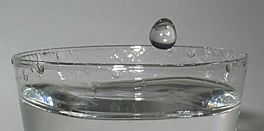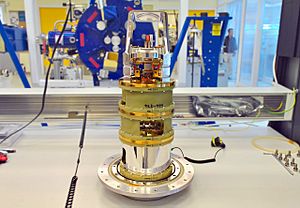Water facts for kids
Quick facts for kids Water (H2O) |
|
|---|---|
 |
|
 |
|
| IUPAC name | water |
| Other names | Hydrogen hydroxide, hydrogen oxide, dihydrogen monoxide |
| Identifiers | |
| CAS number | |
| PubChem | |
| ChEBI | CHEBI:15377 |
| Properties | |
| Molecular formula | |
| Molar mass | 0 g mol-1 |
| Appearance | Clear liquid, white solid (ice), colorless gas (steam) |
| Odor | None |
| Density | Liquid: 0.997 g/mL at 25 °C Solid: 0.9167 g/ml at 0 °C |
| Melting point | |
| Boiling point | |
| N/A | |
| Solubility | Mixes well with methanol, ethanol, acetone, glycerol. |
| Structure | |
| Crystal structure | Hexagonal |
| Molecular shape | Bent |
| Hazards | |
| Main hazards | Drowning Avalanche (as snow)
|
| Except where noted otherwise, data are given for materials in their standard state (at 25 °C, 100 kPa) | |
Water (H2O) is a clear, tasteless, odorless, and almost colorless chemical substance. It covers over 70% of Earth's surface. No known life can live without it.
Lakes, oceans, seas, and rivers are made of water. Precipitation is water that falls from clouds in the sky. It can be rain (liquid) if it's warm, or frozen if it's cold. If water gets very cold (below 0°C), it freezes and becomes ice. If water gets very hot (above 100°C), it boils and becomes steam or water vapor. Water moves around the planet in the water cycle. It is super important for all life on Earth.
Contents
What is water made of?
Water is a fluid. It's the only chemical substance on Earth that naturally exists in three states: liquid, solid (ice), and gas (steam). Water is a molecule made of two hydrogen atoms and one oxygen atom. Its chemical formula is H2O.
Like other liquids, water has surface tension. This is why small amounts of water can form drops on a surface instead of always spreading out.
Words related to water often start with "hydro" or "aqua." For example, hydropower (power from water) or aquarium (a tank for water animals). Water is also called the "universal solvent" because it can dissolve many other compounds.
In small amounts, water looks clear. But in large amounts, like in seas or lakes, it has a very light blue color.
How do we use water?
Plants and animals (including people) are mostly water inside. We all need to drink water to live. Water helps with many important things in our bodies:
- It provides a place for chemical reactions to happen.
- It's the main part of blood.
- It helps keep our body temperature steady by sweating from the skin.
- Water helps blood carry nutrients from the stomach to all parts of the body.
- It helps blood carry oxygen from the lungs to the body.
- Saliva, which helps us digest food, is mostly water.
- Water helps make urine, which removes bad chemicals from the body.
The human body is about 60% to 70% water. Babies have even more water in their bodies!
Water is the main part of many drinks like milk, juice, and wine. These drinks also have other things for flavor or nutrients, like sugar or fruit. Water that people can drink is called "potable water" or "drinking water." The water in oceans is salt water, but lakes and rivers usually have unsalted water. Only about 3% of all the water on Earth is fresh water. The rest is salt water.
Many places, like cities and deserts, don't have enough water. So, they build aqueducts to bring water to them. People can survive a few months without food, but only a day or two without water.
Water is also used for fun activities, like list of water sports. It's used as a coolant in most nuclear reactors. Water is also used for washing things, for transportation (on watercrafts), and in chemical reactions. And, of course, water is used for cooking and fighting fires.
The Dihydrogen Monoxide Parody
The dihydrogen monoxide parody is a joke that calls water by an unfamiliar chemical name, "dihydrogen monoxide" (DHMO). It then lists some of water's effects in a scary way. For example, it might say DHMO "causes burning, suffocation, and corrosion." But it's just talking about hot water, drowning, and rust! Sometimes the joke asks for DHMO to be banned or labeled as dangerous.
This prank works because it tricks people who don't know much about chemistry. By using a strange name and making water sound like a harmful chemical, it can make people think it's dangerous.
"Dihydrogen monoxide" is a real chemical name for water, but almost no one uses it. "Dihydrogen" means two hydrogens, and "monoxide" means one oxygen. Water's chemical formula (H2O) has two hydrogens and one oxygen.
This joke became popular in the 1990s. A 14-year-old named Nathan Zohner used it for a science project to show how easily people can be fooled. His project is now used to teach about critical thinking and the scientific method.
There's even a joke website, DHMO.org, that lists the "harmful effects" of water and calls for it to be banned.
Where did Earth's water come from?
The strange things about water
Water is a bit weird! For example, when water freezes, it expands by about 9%. This is why pipes can break if the water inside them freezes. Also, hot water can sometimes freeze faster than cold water, and scientists are still trying to fully understand why.
Scientists believe that all the water molecules on Earth have been here for billions of years. They think most of it came from space, carried by asteroids and comets. Water is the second most common molecule in the universe!
Water in the universe

A lot of the water in the universe is made when stars form. In 2011, scientists found a giant cloud of water vapor far away in space. It had "140 trillion times more water than all of Earth's oceans combined!" This shows that water has been common in the universe for almost its entire existence.
Water has been found in clouds of gas and dust in our galaxy, the Milky Way. It probably exists in many other galaxies too. The parts of water, hydrogen and oxygen, are very common elements in the universe. So, other planetary systems likely have water too.
How Earth got its water
We don't know exactly how Earth got so much water. It's common in the universe, but it's unusual for a planet to have as much as Earth does. Scientists used to think that Earth's water came only from space, delivered by icy asteroids and planetesimals (small planet-like objects) from the outer parts of our solar system. However, hydrogen already inside the Earth might have also played a role in forming our oceans. It's possible both ideas are partly true.
Water Vapor in Space
Water vapor is the gas form of water. It's found in many places in space:
- The Atmosphere of the Sun has small amounts of water.
- Atmosphere of Mercury: 3.4% water in its outer layer.
- Atmosphere of Venus: 0.002% water.
- Atmosphere of Earth: About 0.4% water overall, and 1–4% near the ground.
- The Moon has tiny amounts of water vapor in its very thin atmosphere.
- Atmosphere of Mars: 0.03% water.
- Atmosphere of Ceres.
- Atmosphere of Jupiter: Has water in the form of ice. Its moon Europa also has water.
- Atmosphere of Saturn: Has water as ice. Its moon Enceladus is 91% ice, and ice is also on Dione.
- Atmosphere of Uranus: Small amounts of ice.
- Atmosphere of Neptune: Ice is found deep in its atmosphere.
- The atmospheres of planets outside our solar system (called extrasolar planets), like HD 189733 b and WASP-12b.
- Stellar atmospheres: Water vapor is found in giant hot stars like Betelgeuse and Arcturus.
Liquid Water in Space
Liquid water is mainly found on Earth, covering about 71% of its surface. Scientists think liquid water might also be found on Jupiter's moons Enceladus, Titan, Europa, and Ganymede. Small amounts of liquid water are sometimes found on Mars.
Frozen Water (Ice) in Space
Ice is found in many places:
- Mars: Water ice is at the north and south poles.
- Earth and the Moon: Mainly as ice sheets on Earth and in craters on the Moon.
- Ceres.
- Jupiter's moons: Europa, Ganymede, and Callisto.
- Saturn: In its planetary rings. Also on Titan and Enceladus.
- Pluto and its moon Charon.
- Comets and other objects in the Kuiper belt and Oort cloud.
|
Related pages
See also
 In Spanish: Agua para niños
In Spanish: Agua para niños






